Sequoia Groves of Yosemite: Visitor Use and Impact Monitoring
Abstract
:1. Introduction
1.1. Sequoia Groves of Yosemite
1.2. Impacts of Visitation
1.3. Desired Conditions
1.3.1. Mariposa Grove (MARI)
- The primary location for visitor enjoyment and interpretation of the giant sequoia, providing the most accessible experience and accommodating the highest levels of use among the three groves. Visitor facilities are consistent with the preservation of the unique ecosystem, and any facilities not necessary for visitor enjoyment of the resource are removed.
1.3.2. Tuolumne Grove (TUOL)
- Visitors can experience relative quiet and levels of low-to-moderate visitation while having access to basic amenities such as restrooms, paved parking, and a walking trail to and through the grove. Visitors can learn about the grove through interpretive signage and basic orientation panels located at the parking area and throughout the walk into the grove.
1.3.3. Merced Grove (MERC)
- The least-developed grove provides enhanced opportunities for quiet where natural sounds dominate, and visitors can hear the breeze rustling through the foliage or the sound of a woodpecker calling or tapping against a tree. Minimal facilities are available.
2. Materials and Methods
2.1. Trail Counter Estimates
2.2. Ground Cover and Compaction
2.3. Social Trail Extent and Condition Assessment
- Is there evidence of social trailing w/in ~8 m of the tree base (i.e., does there appear to be a footpath leading to the tree and/or a bare area due to visitor activity)?—Y/N;
- Does it have clear/unclear boundaries (i.e., is it faint or well-defined)?—Faint/well-defined;
- Is any portion of the social trail greater than 0.5 m wide?—Y/N.
3. Results
3.1. Visitor Use, Volume, and Timing
3.2. Ground Cover and Compaction
3.3. Social Trail Extent and Condition Assessment
4. Discussion
5. Conclusions
Author Contributions
Funding
Data Availability Statement
Acknowledgments
Conflicts of Interest
References
- Willard, D. The Natural Giant Sequoia (Sequoiadendron giganteum) groves of the Sierra Nevada, California: An Updated Annotated List. In Proceedings of the Symposium on Giant Sequoias: Their Place in the Ecosystem and Society, Visalia, CA, USA, 23–25 June 1992; USDA: Washington, DC, USA, 1994; pp. 159–164. Available online: https://www.fs.usda.gov/psw/publications/documents/psw_gtr151/psw_gtr151_28_willard.pdf (accessed on 3 August 2024).
- Rundel, P.W. An annotated check list of the groves of Sequoiadendron giganteum in the Sierra Nevada, California. Madrono 1972, 21, 319–328. Available online: https://www.jstor.org/stable/41423799 (accessed on 3 August 2024).
- Vale, T.R. Ecology and environmental issues of the Sierra Redwood (Sequoiadendron giganteum), now restricted to California. Environ. Conserv. 1975, 2, 179–188. [Google Scholar] [CrossRef]
- Martin, R.H.; Hodge, J.B.; Whitesides, C.J. A modern perspective on Meinecke’s 1929 assessment of tourist impacts on redwoods. Prog. Phys. Geogr. Earth Environ. 2022, 46, 152–160. [Google Scholar] [CrossRef]
- Meinecke, E.P. Tree Giants in the Sequoia Groves are Menaced by Tourists. In Yearbook of Agriculture; Crawford, N.A., Chew, A.P., Eds.; US Government Printing Office: Washington, DC, USA, 1927; pp. 633–635. [Google Scholar]
- Parsons, D.J. Objects or Ecosystems? Giant Sequoia Management in National Parks. In PS Aune [Technical Coordinator], Proceedings of the Symposium on the Giant Sequioas: Their Place in the Ecosystem and Society, Visalia, CA, USA, 23–25 June 1992; U.S. Department of Agriculture Forest Service: Washington, DC, USA; pp. 109–115. Available online: http://npshistory.com/publications/seki/giant-sequoia-mgt.pdf (accessed on 3 August 2024).
- Piirto, D.D.; Rogers, R.R. An ecological basis for managing giant sequoia ecosystems. Environ. Manag. 2002, 30, 110–128. [Google Scholar] [CrossRef] [PubMed]
- Jenkins, J.; Brown, M. Giant sequoia—Forest, monument, or park?: Political-legal mandates and socio-ecological complexity shaping landscape-level management. Soc. Nat. Resour. 2020, 33, 721–737. [Google Scholar] [CrossRef]
- Weatherspoon, C.P. Sequoiadendron giganteum (Lindl.) Buchholz giant sequoia. Silv. N. Am. 1990, 1, 552–562. [Google Scholar]
- Hartesveldt, R.J. The Effects of Human Impact upon Sequoia gigantea and Its Environment in the Mariposa Grove, Yosemite National Park, California; University of Michigan: Ann Arbor, MI, USA, 1963. [Google Scholar]
- Carey, C.J.; Glassman, S.I.; Bruns, T.D.; Aronson, E.L.; Hart, S.C. Soil microbial communities associated with giant sequoia: How does the world’s largest tree affect some of the world’s smallest organisms? Ecol. Evol. 2020, 10, 6593–6609. [Google Scholar] [CrossRef]
- Matulewski, P.; Buchwal, A.; Zielonka, A.; Wrońska-Wałach, D.; Čufar, K.; Gärtner, H. Trampling as a major ecological factor affecting the radial growth and wood anatomy of Scots pine (Pinus sylvestris L.) roots on a hiking trail. Ecol. Indic. 2021, 121, 107095. [Google Scholar] [CrossRef]
- National Park Service. Restoration of the Mariposa Grove of Giant Sequoias. Final Environmental Impact Statement. 2013. Available online: https://parkplanning.nps.gov/document.cfm?parkID=347&documentID=56090 (accessed on 3 August 2024).
- Marion, J.L.; Leung, Y.F.; Nepal, S.K. Monitoring trail conditions: New methodological considerations. In The George Wright Forum; George Wright Society: Hancock, MI, USA, 2006; Volume 23, pp. 36–49. Available online: https://www.jstor.org/stable/43598937 (accessed on 3 August 2024).
- Monz, C.A.; Cole, D.N.; Leung, Y.F.; Marion, J.L. Sustaining visitor use in protected areas: Future opportunities in recreation ecology research based on the USA experience. Environ. Manag. 2010, 45, 551–562. [Google Scholar] [CrossRef]
- Forman, R.T. Land Mosaics: The Ecology of Landscapes and Regions; Cambridge University Press: Cambridge, MA, USA, 1995. [Google Scholar]
- Knight, R.L. Forest fragmentation and outdoor recreation in the southern Rocky Mountains. In Forest Fragmentation in the Southern Rocky Mountains; University Press of Colorado: Boulder, CO, USA, 2000; pp. 135–153. [Google Scholar]
- Leote, P.; Cajaiba, R.L.; Moreira, H.; Gabriel, R.; Santos, M. The importance of invertebrates in assessing the ecological impacts of hiking trails: A review of its role as indicators and recommendations for future research. Ecol. Indic. 2022, 137, 108741. [Google Scholar] [CrossRef]
- Wimpey, J.; Marion, J.L. A spatial exploration of informal trail networks within Great Falls Park, VA. J. Environ. Manag. 2011, 92, 1012–1022. Available online: https://www.sciencedirect.com/science/article/pii/S0301479710004184 (accessed on 3 August 2024). [CrossRef] [PubMed]
- Sadeghi, S.; Solgi, A.; Tsioras, P.A. Effects of traffic intensity and travel speed on forest soil disturbance at different soil moisture conditions. Int. J. For. Eng. 2022, 33, 146–154. [Google Scholar] [CrossRef]
- Cole, D.N. Experimental trampling of vegetation. I. Relationship between trampling intensity and vegetation response. J. Appl. Ecol. 1995, 32, 203–214. Available online: https://www.jstor.org/stable/2404429 (accessed on 3 August 2024). [CrossRef]
- Hartley, E. Visitor impacts at Logan Pass. Glacier National Park: A thirty-year vegetation study. In On the Frontiers of Conservation: Proceedings of the 10th Conference on Research and Management in National Parks and on Public Lands; The George Wright Society: Hancock, MI, USA, 1999; pp. 297–305. [Google Scholar]
- Pescott, O.L.; Stewart, G.B. Assessing the impact of human trampling on vegetation: A systematic review and meta-analysis of experimental evidence. PeerJ 2014, 2, e360. [Google Scholar] [CrossRef] [PubMed]
- Cole, D.N. Research on soil and vegetation in wilderness: A state-of-knowledge review. Gen. Tech. Rep. INT 1987, 220, 135e177. [Google Scholar]
- Cole, D.N. Wilderness Campsite Impacts: United States Department of Agriculture, Forest Service, Intermountain Forest and Range Experiment Station. 1982. Available online: https://www.fs.usda.gov/rm/pubs_int/int_rp284.pdf (accessed on 3 August 2024).
- Cole, D.N.; Monz, C.A. Spatial patterns of recreation impact on experimental campsites. J. Environ. Manag. 2004, 70, 73–84. [Google Scholar] [CrossRef]
- Growcock, A.J.W. Impacts of Camping and Trampling on Australian Alpine and Subalpine Vegetation and Soils. Ph.D. Thesis, Griffith University, Nathan, Australia, 2005, unpublished. [Google Scholar] [CrossRef]
- Monz, C.A.; Pickering, C.M.; Hadwen, W.L. Recent advances in recreation ecology and the implications of different relationships between recreation use and ecological impacts. Front. Ecol. Environ. 2013, 11, 441–446. [Google Scholar] [CrossRef]
- Cole, D.N. The Relationship Between Amount of Visitor Use and Environmental Impacts. Prepared for the Interagency Visitor Use Management Council; Interagency Visitor Use Management Council: Lakewood, CO, USA, 2019; pp. 1–12.
- Herbauts, J.; El Bayad, J.; Gruber, W. Influence of logging traffic on the hydromorphic degradation of acid forest soils developed on loessic loam in middle Belgium. For. Ecol. Manag. 1996, 87, 193–207. [Google Scholar] [CrossRef]
- Coder, K.D. Causes of Soil Compaction; University of Georgia, Warnell School of Forest Resources: Athens, GA, USA, 2000. [Google Scholar]
- Manning, R.E.; Anderson, L.E.; Pettengill, P. Managing Outdoor Recreation: Case Studies in the National Park; CABI: Wallingford, UK, 2017. [Google Scholar]
- Hammitt, W.E.; Cole, D.N.; Monz, C.A. Wildland Recreation: Ecology and Management; John Wiley & Sons: Hoboken, NJ, USA, 2015. [Google Scholar]
- Busse, M.D.; Fiddler, G.O.; Shestak, C.J. Conifer root proliferation after 20 years of soil compaction. For. Sci. 2016, 63, 147–150. [Google Scholar] [CrossRef]
- Zinke, P.J. Vegetation Change at Recreation Sites in the Redwood Region; Recreation in Wildland Management; University of California School of Forestry, Berkeley: Berkeley, CA, USA, 1962; pp. 1–12. [Google Scholar]
- Krenzelok, S.R. The Effects of Human Trampling on Soil Compaction and Vegetation in a Sequoia sempervirens Community; Unpublished Report, Natural Resources Files (Vegetation); Muir Woods National Monument: Mill Valley, CA, USA, 1974. [Google Scholar]
- McBride, J.; Jacobs, D. Vegetation History of Muir Woods National Monument; USDI National Park Service, Western Region: San Francisco, CA, USA, 1978.
- Voigt, C. Impacts of Social Trails Around Old-Growth Redwood Trees in Redwood National and State Parks. 2016. Available online: https://scholarworks.calstate.edu/concern/theses/0v8382720 (accessed on 3 August 2024).
- Olmsted, F.L.; Roper, L.W. The Yosemite Valley and the Mariposa big trees: A preliminary Report (1865). Landsc. Archit. 1952, 43, 12–25. Available online: https://www.jstor.org/stable/44659746 (accessed on 3 August 2024).
- Runte, A. Yosemite: The Embattled Wilderness; U of Nebraska Press: Lincoln, NE, USA, 1993. [Google Scholar]
- Cronon, W. The trouble with wilderness: Or, getting back to the wrong nature. Environ. Hist. 1996, 1, 7–28. [Google Scholar] [CrossRef]
- Brunner, E.A.; Dawson, V.R. Marketing the recreational sublime: Jumbo Wild and the rhetorics of humans in nature. Crit. Stud. Media Commun. 2017, 34, 386–399. [Google Scholar] [CrossRef]
- Pyne, S.J. Pyrocene Park: A Journey into the Fire History of Yosemite National Park; University of Arizona Press: Tucson, AZ, USA, 2023. [Google Scholar]
- Piovesan, G.; Biondi, F.; Baliva, M.; Dinella, A.; Di Fiore, L.; Marchiano, V.; Saba, E.P.; De Vivo, G.; Schettino, A.; Di Filippo, A. Tree growth patterns associated with extreme longevity: Implications for the ecology and conservation of primeval trees in Mediterranean mountains. Anthropocene 2019, 26, 100199. [Google Scholar] [CrossRef]
- National Park Service. Yosemite NP Annual Park Recreation Visits. Integrated Resource Management Applications. 2024. Available online: https://irma.nps.gov/Stats/Reports/Park/YOSE (accessed on 3 August 2024).
- National Park Service. Yosemite General Management Plan. 1980. Available online: http://www.nps.gov/yose/parkmgmt/upload/YOSE_104_D1316B_-id338162.pdf (accessed on 3 August 2024).
- National Park Service. Visitor Access Management Draft Plan and Environmental Assessment. 2024. Available online: https://parkplanning.nps.gov/document.cfm?documentID=138824 (accessed on 14 August 2024).
- Marion, J.L.; Leung, Y.F. Indicators and protocols for monitoring impacts of formal and informal trails in protected areas. J. Tour. Leis. Stud. 2011, 17, 215–236. Available online: https://pubs.usgs.gov/publication/70005574 (accessed on 3 August 2024).
- Leung, Y.F.; Shaw, N.; Johnson, K.; Duhaime, R. More than a database: Integrating GIS data with the Boston Harbor Islands visitor carrying capacity study. In The George Wright Forum; George Wright Society: Hancock, MI, USA, 2002; Volume 19, pp. 69–78. Available online: https://www.jstor.org/stable/43597789 (accessed on 3 August 2024).
- Cole, D.N.; Watson, A.E.; Hall, T.E.; Spildie, D.R. High-Use Destinations in Wilderness: Social and Biophysical Impacts, Visitor Responses, and Management Options; Research Paper INT-RP-496; USDA Forest Service, Intermountain Research Station: Ogden, UT, USA, 1997.
- Marion, J.L. Trail sustainability: A state-of-knowledge review of trail impacts, influential factors, sustainability ratings, and planning and management guidance. J. Environ. Manag. 2023, 340, 117868. [Google Scholar] [CrossRef]
- United States Geological Survey. One (1) Meter Digital Elevation Models (DEMs); USGS National Map 3DEP Downloadable Data Collection: Reston, VA, USA; U.S. Geological Survey: Reston, VA, USA, 2023.
- Rundel, P.W. The Distribution and Ecology of the Giant Sequoia Ecosystem in the Sierra Nevada, California; Duke University: Durham, NC, USA, 1970. [Google Scholar]
- Desta, F.; Colbert, J.J.; Rentch, J.S.; Gottschalk, K.W. Aspect induced differences in vegetation, soil, and microclimatic characteristics of an Appalachian watershed. Castanea 2004, 69, 92–108. [Google Scholar] [CrossRef]
- Salesa, D.; Cerdà, A. Soil erosion on mountain trails as a consequence of recreational activities. A comprehensive review of the scientific literature. J. Environ. Manag. 2020, 271, 110990. [Google Scholar] [CrossRef]
- Vaquero, R. Soil Physical Properties and Banana Root Growth. Proceedings Banana Root System: Toward a Better Understanding for Its Productive Management. 2003, pp. 125–131. Available online: https://dendro.cnre.vt.edu/dendrology/USDAFSSilvics/136.pdf (accessed on 3 August 2024).
- Amacher, M.C. Assessing Soil Compaction on Forest Inventory & Analysis Phase 3 Field Plots Using a Pocket Penetrometer; US Department of Agriculture, Forest Service, Rocky Mountain Research Station: Fort Collins, CO, USA, 2004. Available online: https://www.fs.usda.gov/rm/pubs/rmrs_rp046.pdf (accessed on 3 August 2024).
- Gifford, G.F.; Faust, R.H.; Coltharp, G.B. Measuring soil compaction on rangeland. Rangel. Ecol. Manag./J. Range Manag. Arch. 1977, 30, 457–460. [Google Scholar] [CrossRef]
- Hill, E.M.; Ex, S. Microsite conditions in a low-elevation Engelmann spruce forest favor ponderosa pine establishment during drought conditions. For. Ecol. Manag. 2020, 463, 118037. [Google Scholar] [CrossRef]
- Stark, N. Seed ecology of Sequoiadendron giganteum. Madroño 1968, 19, 267–277. [Google Scholar]
- Fahey, C.; York, R.A.; Pawlowska, T.E. Arbuscular mycorrhizal colonization of giant sequoia (Sequoiadendron giganteum) in response to restoration practices. Mycologia 2012, 104, 988–997. [Google Scholar] [CrossRef] [PubMed]
- Longepierre, M.; Widmer, F.; Keller, T.; Weisskopf, P.; Colombi, T.; Six, J.; Hartmann, M. Limited resilience of the soil microbiome to mechanical compaction within four growing seasons of agricultural management. ISME Commun. 2021, 1, 44. [Google Scholar] [CrossRef] [PubMed]
- Miransari, M. Mycorrhizal fungi to alleviate compaction stress on plant growth. In Use of Microbes for the Alleviation of Soil Stresses: Volume 2: Alleviation of Soil Stress by PGPR and Mycorrhizal Fungi; Springer: New York, NY, USA, 2014. [Google Scholar] [CrossRef]
- Etana, A.; Larsbo, M.; Keller, T.; Arvidsson, J.; Schjønning, P.; Forkman, J.; Jarvis, N. Persistent subsoil compaction and its effects on preferential flow patterns in a loamy till soil. Geoderma 2013, 192, 430–436. [Google Scholar] [CrossRef]
- Ibsen, P.C.; Santiago, L.S.; Shiflett, S.A.; Chandler, M.; Jenerette, G.D. Irrigated urban trees exhibit greater functional trait plasticity compared to natural stands. Biol. Lett. 2023, 19, 20220448. [Google Scholar] [CrossRef] [PubMed]
- McKinley, D.C.; Miller-Rushing, A.J.; Ballard, H.L.; Bonney, R.; Brown, H.; Cook-Patton, S.C.; Evans, D.M.; French, R.A.; Parrish, J.K.; Phillips, T.B.; et al. Citizen science can improve conservation science, natural resource management, and environmental protection. Biol. Conserv. 2017, 208, 15–28. [Google Scholar] [CrossRef]
- Jacobson, S.K.; Morris, J.K.; Sanders, J.S.; Wiley, E.N.; Brooks, M.; Bennetts, R.E.; Percival, H.F.; Marynowski, S. Understanding barriers to implementation of an adaptive land management program. Conserv. Biol. 2006, 20, 1516–1527. [Google Scholar] [CrossRef]
- Marin, L.D.; Newman, P.; Manning, R.; Vaske, J.J.; Stack, D. Motivation and acceptability norms of human-caused sound in Muir Woods National Monument. Leis. Sci. 2011, 33, 147–161. [Google Scholar] [CrossRef]
- Jenkins, J.; Jenkins, M.W. Managed migration of coast redwoods: Subjectivity of stakeholders in Oregon’s land use planning community. Environ. Nat. Resour. Res. 2017, 7, 1. [Google Scholar] [CrossRef]
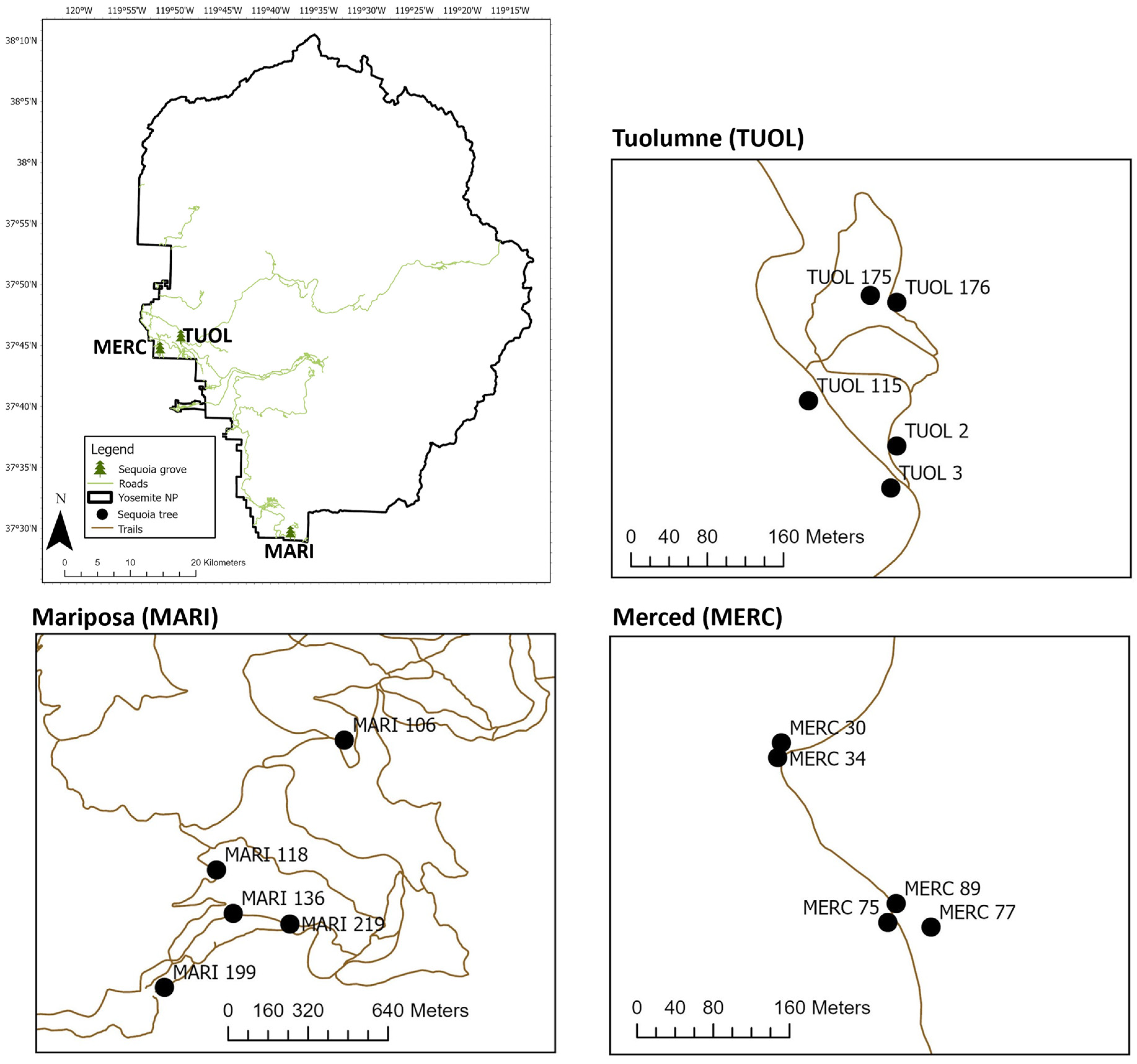
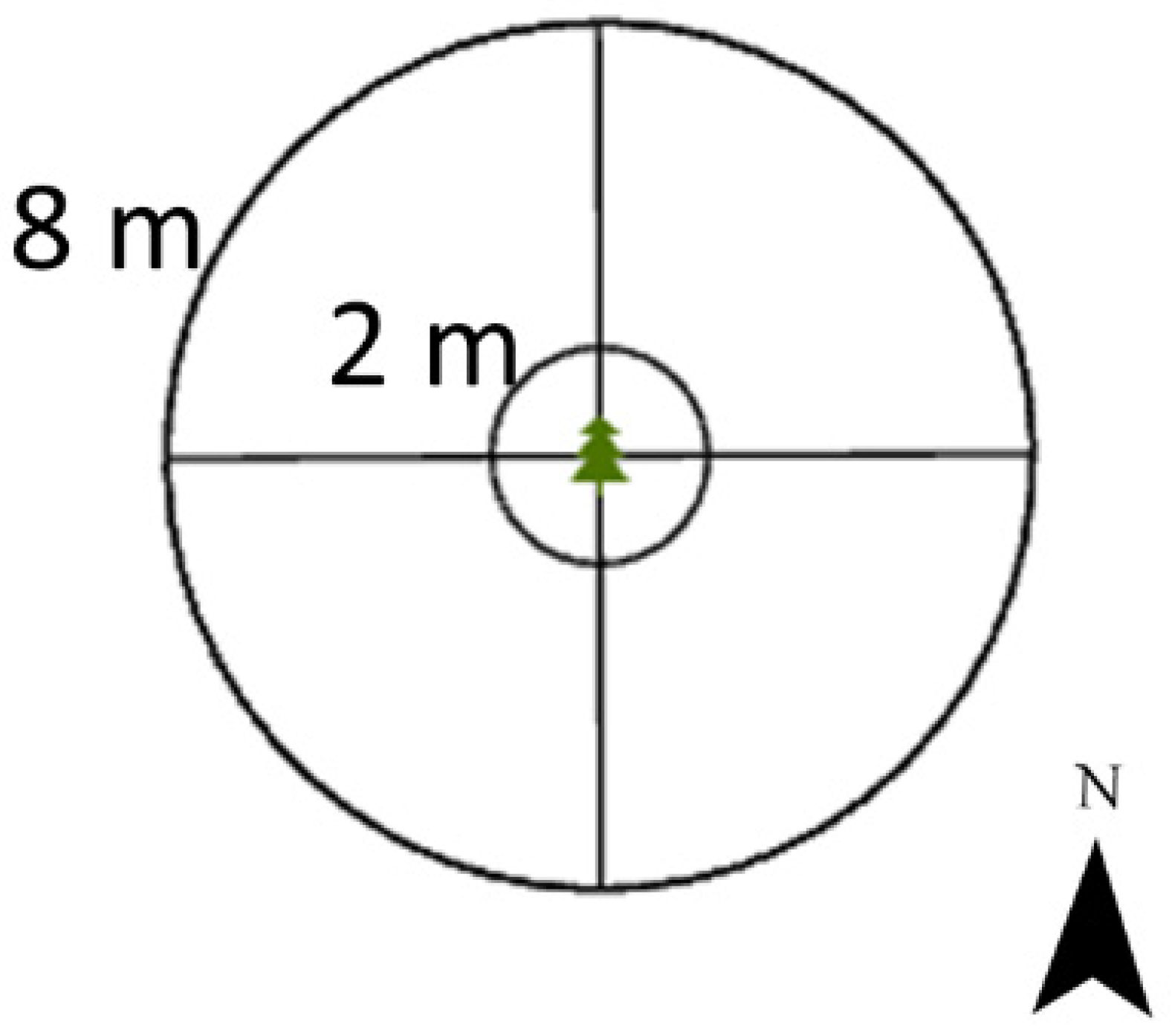
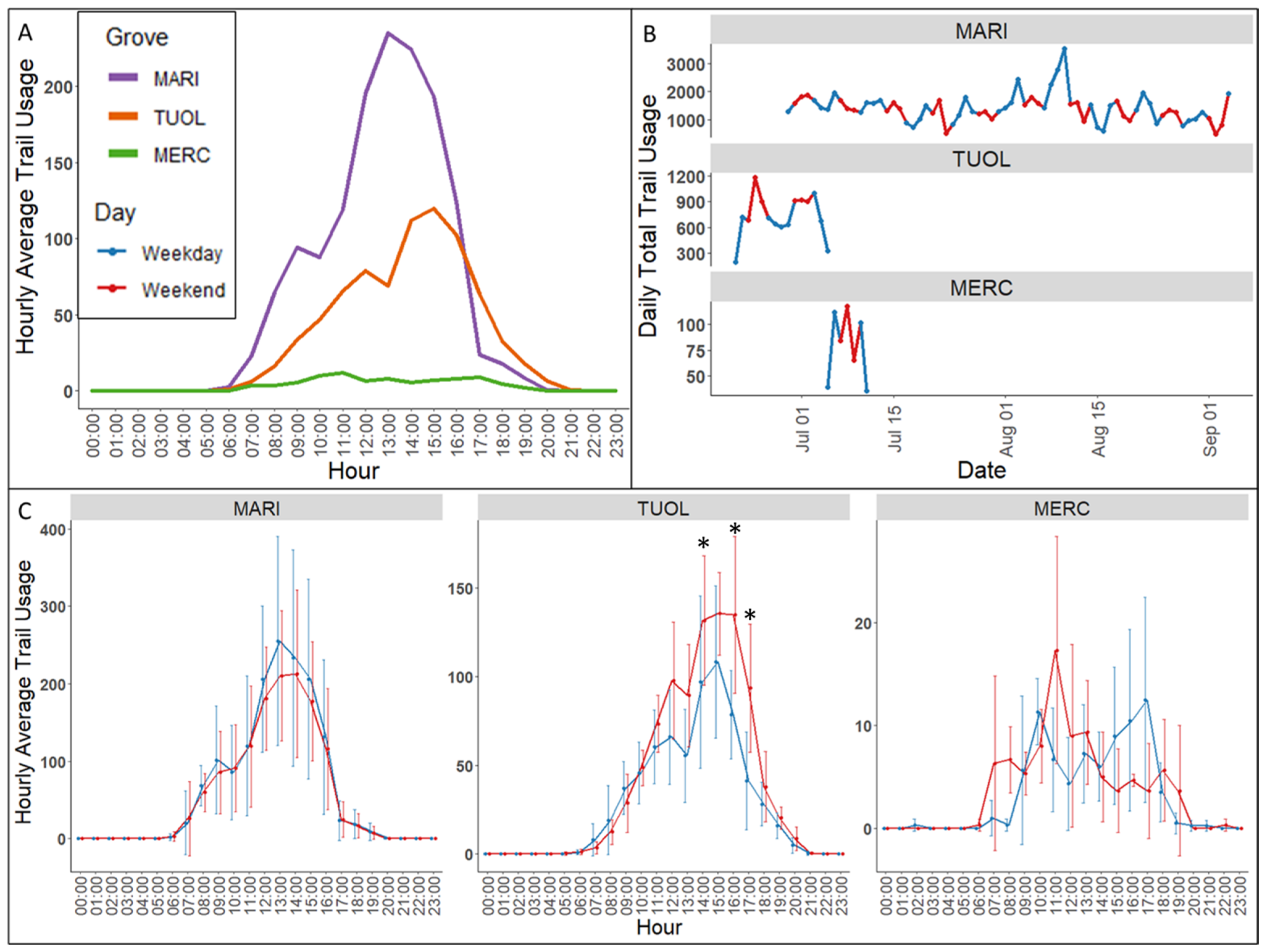
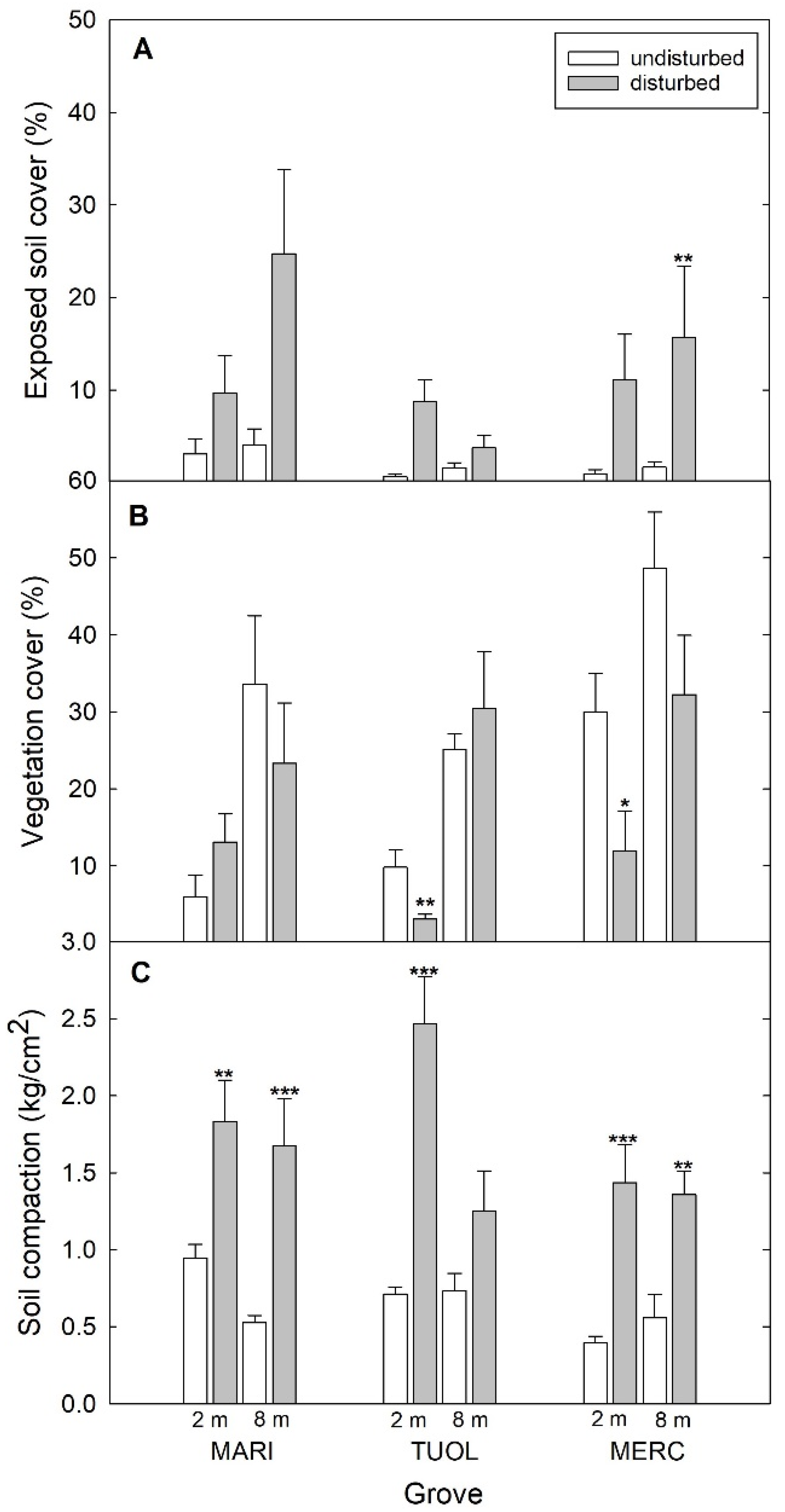
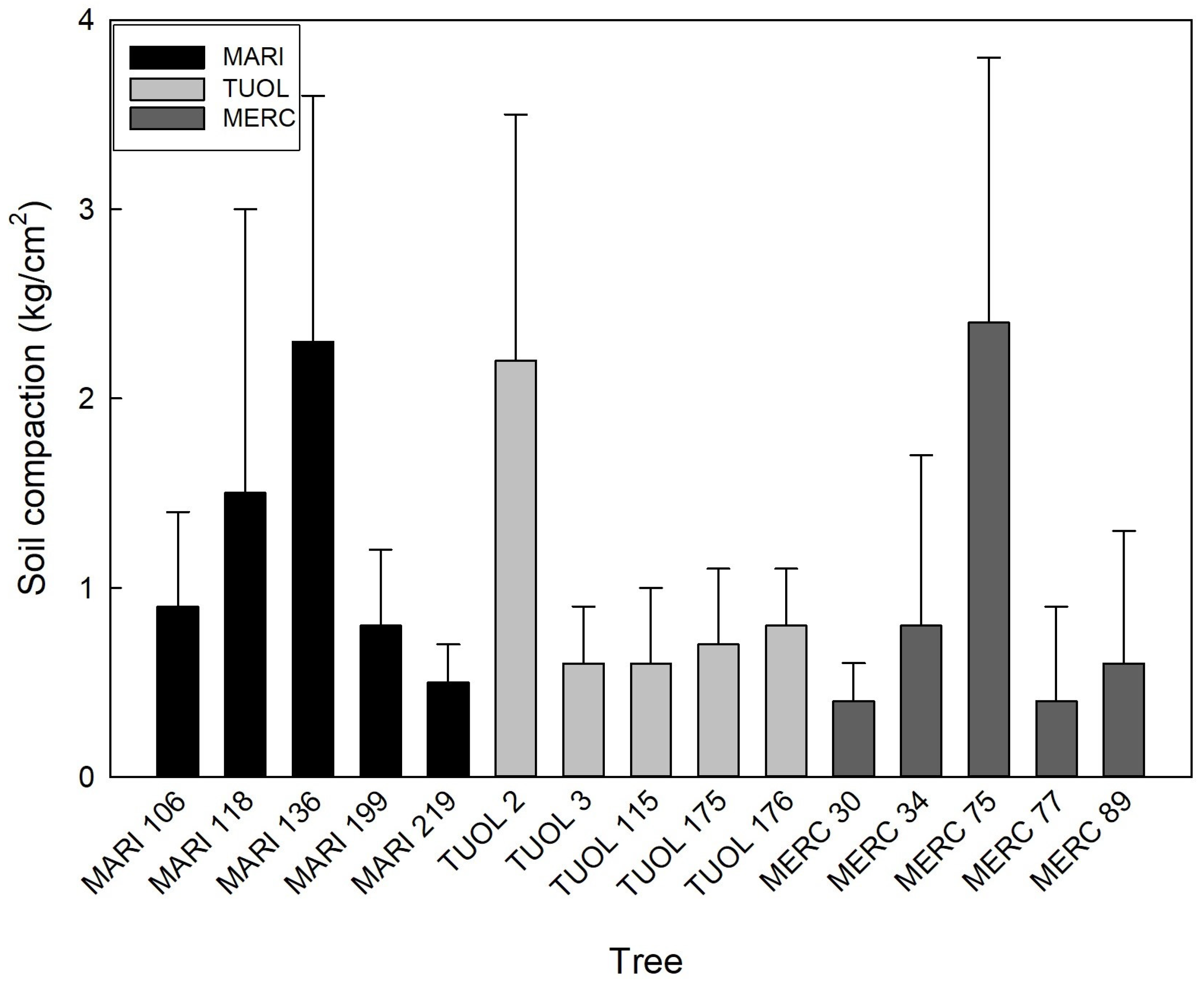
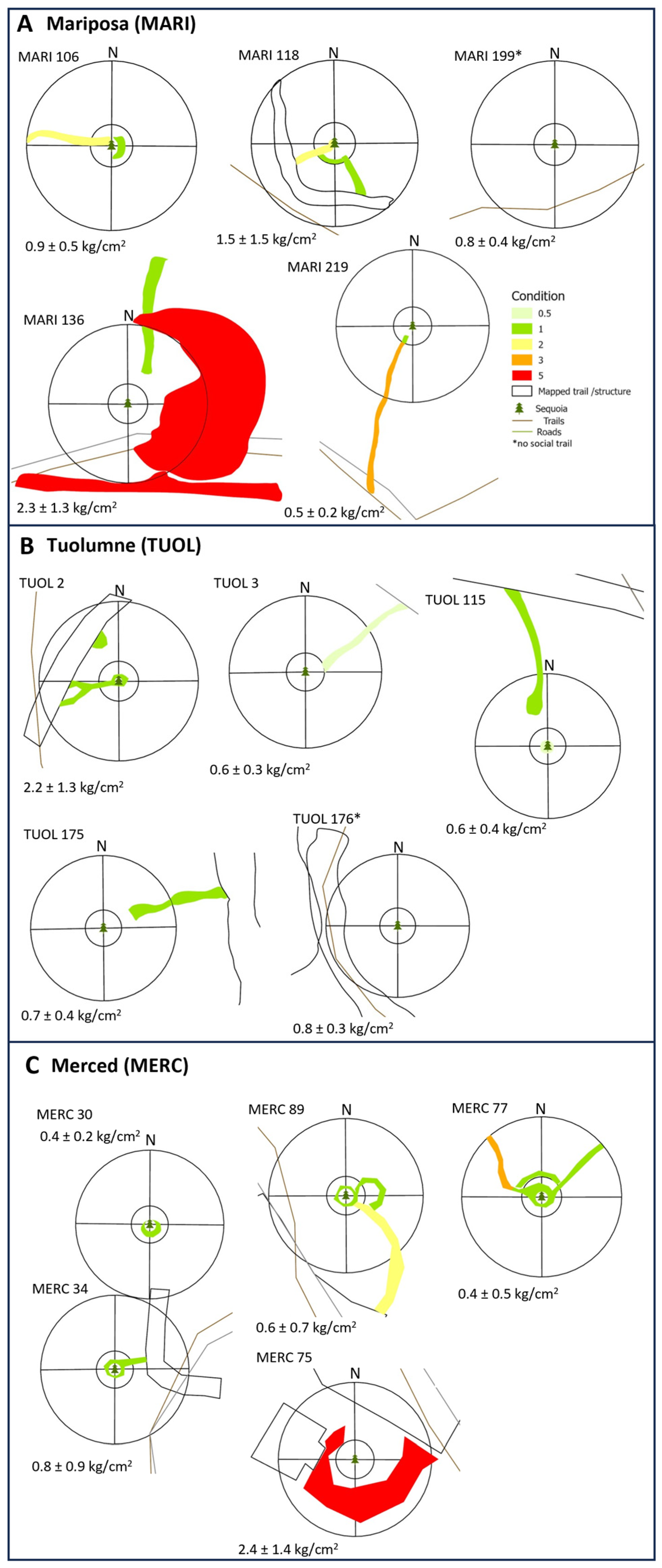

| Mutually Exclusive Set of Categories, Which Total 100% | Description | |
|---|---|---|
| Organic Cover Elements | Exposed roots, burl, or woody debris | Roots or burl with damaged or removed bark. Woody debris damaged by trampling. |
| Exposed soil | Litter layer is completely removed. Depending on the depth of the O-horizon, either black, well-decomposed soil or mineral soil is visible. | |
| Organic litter | Dead plant material, e.g., twigs, bark, needles, and leaves, that have fallen to the ground and have not yet been incorporated into the decomposed top humus layer. N.B. Litter that has been pulverized by trampling is not included and is classified as bare soil. Additionally, twigs > 5 cm diameter, bark > 5 cm length or width, and all pinecones are included in woody debris estimates. | |
| Woody and organic debris | Woody material, slash and debris, fallen dead trees, and the remains of branches on the ground (>5 cm diameter). See the above category for more details. | |
| Vegetation | Including trees, shrubs, ferns, forbs, and graminoids. For canopy vegetation (i.e., trees), cover was limited to the ground footprint of the mainstem(s), whereas for understory and forest floor vegetation, cover estimates included foliage. | |
| Other Cover Elements | Established trail/road | Includes dirt and paved surfaces, marked and used as official trails and/or roads. |
| Rocks | Includes masses of mineral matter > 5 cm length or width. | |
| Stream | Channel with water present. | |
| Structure | Footprint of physical structure. | |
| Additional set of categories, which total 100% | ||
| Social Trail Cover | Disturbed area (social trail(s)/trampling disturbance present) | Area affected by trampling and/or covered with social trails. |
| Undisturbed area (social trails absent) | Area without visible trampling disturbance and without discernible social trails. |
| Condition Class | Marion and Leung [48], Assessment of Informal Trails | Leung et al. [49], Social Trails, and Cole et al. [50], High-Use Wilderness Areas | Sequoia Groves of Yosemite NP |
|---|---|---|---|
| 0.5 | Trail not obvious, though the area appears as if disturbed by human foot traffic, slight loss of vegetation cover and/or minimal disturbance of organic litter. | ||
| 1 | Trail distinguishable; slight loss of vegetation cover and/or minimal disturbance of organic litter. | Trails are disturbed but not well established. They retain at least 20% of vegetation cover on the treads. The boundaries between trail treads and off-trail areas are often unclear. | Social trail(s) (just) distinguishable, the boundaries between trail treads and off-trail areas are often unclear; slight loss of vegetation cover and minimal disturbance of organic litter |
| 2 | Trail obvious; vegetation cover lost and/or organic litter pulverized in primary use areas. | Trails are well established. They retain less than 20% of vegetation cover on the treads. These trails are less than 0.3 m wide. The boundaries between trail treads and off-trail areas are often discernible. | Social trail obvious, but maybe not used recently; on-trail vegetation cover lost and/or litter diminished in primary use areas. |
| 3 | Vegetation cover lost and/or organic litter pulverized within the center of the tread, some bare soil exposed. | Trails are well established. They retain less than 20% of vegetation cover on the treads and are between 0.3 and 0.6 m wide. The boundaries between trail treads and off-trail areas are usually discernible. | Social trail obvious and well used, vegetation cover lost and/or organic litter pulverized within the center of the tread, some bare soil exposed. |
| 4 | Nearly complete or total loss of vegetation cover and organic litter within the tread, with bare soil widespread. | Trails are well established. They retain less than 20% of vegetation cover on the treads and are more than 0.6 m wide. The boundaries between trail treads and off-trail areas are usually discernible. | Social trail(s) are hard to distinguish from formal trails (i.e., have a similar appearance). Nearly complete or total loss of vegetation cover and organic litter pulverized within the tread, with bare soil widespread. |
| 5 | Soil erosion is obvious, as indicated by exposed roots and rocks and/or gullying. | Disturbance spread over a large area, with no boundaries to identify trail tread, nearly complete or total loss of vegetation cover, and organic litter pulverized in the whole area, bare soil widespread |
| Trail Condition Class | ||||||||
|---|---|---|---|---|---|---|---|---|
| Grove | 0.5 | 1 | 2 | 3 | 4 | 5 | Total Area (m2) | % of Area Sampled |
| MARI | 0 | 11 | 9 | 3 | 0 | 41 | 64 | 6 |
| TUOL | 6 | 17 | 0 | 0 | 0 | 0 | 23 | 2 |
| MERC | 0 | 22 | 6 | 3 | 0 | 50 | 81 | 8 |
Disclaimer/Publisher’s Note: The statements, opinions and data contained in all publications are solely those of the individual author(s) and contributor(s) and not of MDPI and/or the editor(s). MDPI and/or the editor(s) disclaim responsibility for any injury to people or property resulting from any ideas, methods, instructions or products referred to in the content. |
© 2024 by the authors. Licensee MDPI, Basel, Switzerland. This article is an open access article distributed under the terms and conditions of the Creative Commons Attribution (CC BY) license (https://creativecommons.org/licenses/by/4.0/).
Share and Cite
Shiflett, S.A.; Jenkins, J.S.; Mattos, R.F.; Ibsen, P.C.; Athearn, N.D. Sequoia Groves of Yosemite: Visitor Use and Impact Monitoring. Forests 2024, 15, 2256. https://doi.org/10.3390/f15122256
Shiflett SA, Jenkins JS, Mattos RF, Ibsen PC, Athearn ND. Sequoia Groves of Yosemite: Visitor Use and Impact Monitoring. Forests. 2024; 15(12):2256. https://doi.org/10.3390/f15122256
Chicago/Turabian StyleShiflett, Sheri A., Jeffrey S. Jenkins, Rachel F. Mattos, Peter C. Ibsen, and Nicole D. Athearn. 2024. "Sequoia Groves of Yosemite: Visitor Use and Impact Monitoring" Forests 15, no. 12: 2256. https://doi.org/10.3390/f15122256
APA StyleShiflett, S. A., Jenkins, J. S., Mattos, R. F., Ibsen, P. C., & Athearn, N. D. (2024). Sequoia Groves of Yosemite: Visitor Use and Impact Monitoring. Forests, 15(12), 2256. https://doi.org/10.3390/f15122256







